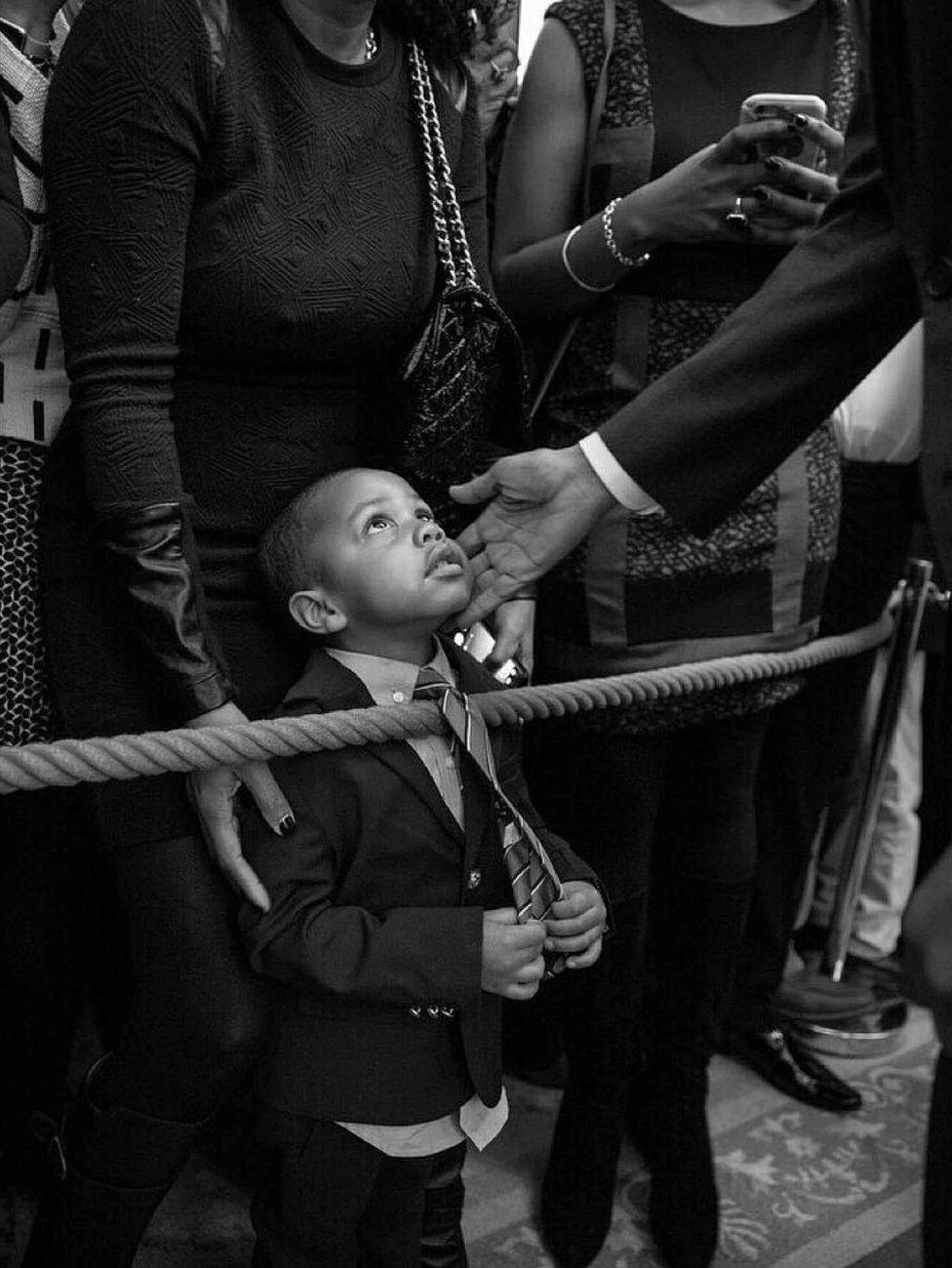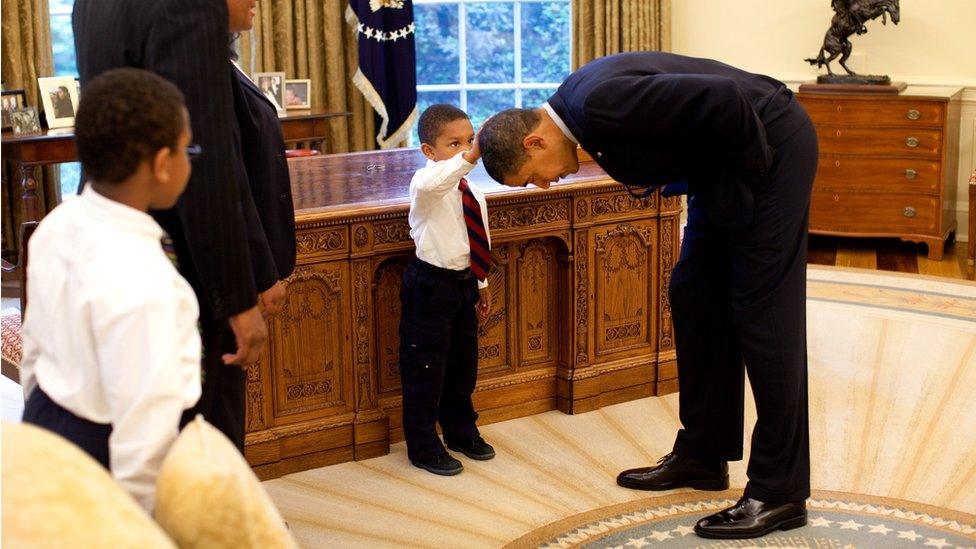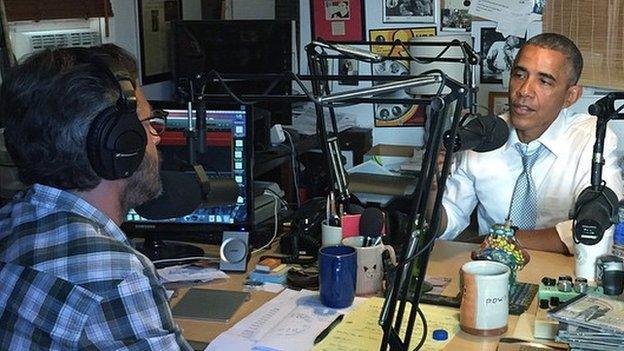Obama's 'blackest' Black History Month
- Published
106-year-old Virginia McLaurin broke into a dance with Barack and Michelle Obama
Of all the visitors to the White House for this year's Black History Month, the last of Barack Obama's presidency, two stood out.
With 103 years between them, one had witnessed first hand the years of fierce struggle that laid the ground for a black president, the other had never lived under a white one.
The cameras captured Virginia McLaurin, aged 106, dancing with President Obama and, separately, Clark Reynolds, aged three, gazing up as the president touched his cheek.
Later, at a reception for the guests, someone called out "Hey Michelle" to the First Lady. The president quipped: "We know it's Black History Month when you hear somebody say, 'Heyyy, Michelle! Girl, you look so good!'"
The three moments were all huge social media hits - the video of Mrs McLaurin's dance has been viewed nearly 35 million times; the image of Clark Reynolds shared nearly 30,000 times on Instagram; and the response to the video of the president's "Hey Girl" moment emphatic.
But at a time when the focus is shifting from Mr Obama's presidency to his legacy, these bite-sized moments raise bigger questions about the part race plays in the mark he leaves on the nation.
Many believe that just the presence of a black family in the White House will have a profound and lasting impact on the aspirations of the country's African Americans. Others have accused Mr Obama of dealing in symbolism over policy.

Clark Reynolds, three, gazes up as the president touches his cheek
For Jonathan Capehart, a member of the Washington Post's editorial board who covers race and politics, it is impossible to overstate the impact of seeing a black family in the White House.
"It is indescribable for most African Americans to see that man and that family in that house," he says. "It's difficult even to answer the question because it is such a powerful thing."
Seeing Mrs McLaurin dancing with the president reminded Mr Capehart him of taking his own mother - a 70-year-old black woman born and raised in North Carolina - to the White House to meet the Obamas.
"She grew up in the segregated South, picked cotton in the cotton fields... and there we were, queuing up to meet a black president and his black wife. The look on her face, it was as if she was seeing a unicorn.
"For Virginia McLaurin, for my mother, this is a dream come true. They never thought they would live to see the day that someone black would be elected president of the United States.
"And for that little boy, and for young black kids around the country, seeing that someone who looks like them has been given the awesome responsibility of leading the nation is just huge."
President Obama: "We know it's Black History Month when you hear somebody say 'Hey Michelle, girl, you look so good'"
The photograph of Clark Reynolds is indeed a powerful one. It harks back to another image of a young black boy in the White House - in 2012, five-year-old Jacob Philadelphia was pictured in the Oval Office reaching out to touch the president's hair, to see if it felt the same as his.
Pete Souza, the White House photographer who took the picture of Clark, said of the earlier image: "As a photographer, you know when you have a unique moment. But I didn't realise the extent to which this one would take on a life of its own."
Michael Skolnik, an activist who shared the image of Clark Reynolds online and created the #Obamaandkids hashtag, wrote: "We'll never truly be able to measure the impact that President Barack Obama has had on our children."
But not everyone was won over by the symbolism of the celebrations. Aislinn Pulley, the Chicago leader of the Black Lives Matter campaign, publicly refused, external her invitation to the White House, calling the event a "sham" and accusing the president of not taking enough action over police brutality.

President Obama bends down so five-year-old Jacob Philadelphia can feel his hair
It was not the first time the accusation had been levelled - a vocal minority of black activists and writers have long accused the president of not doing enough in hard policy terms to help the African American community.
Frederick Harris, a political scientist at Columbia University, says the Obama administration has always suffered from a tension between symbolism and substance when it comes to race.
"I think he is concerned about his legacy and concerned about there not being enough substantive policy outcomes for African Americans," Mr Harris says.
"If you look at past Black History Month events, the Obamas were certainly not as visible, not as 'unapologetically black' - as the Black Lives Matter campaigners would say - as they have been this year."
With both houses of Congress dominated by Republicans, and the chances of passing meaningful legislation thin, the president is "doubling down" on the symbolism, Mr Harris says.
"This is the something the White House has been trading on for a while, the symbolism of the little boy who touches the president's head, or the rhetoric in 2008, but I think it has become more explicit in the waning days of his term.
"As I joked recently to a friend: the closer Obama's foot gets to the door, the blacker the White House becomes."
- Published23 February 2016

- Published23 June 2015

- Published22 June 2015

- Published22 June 2015